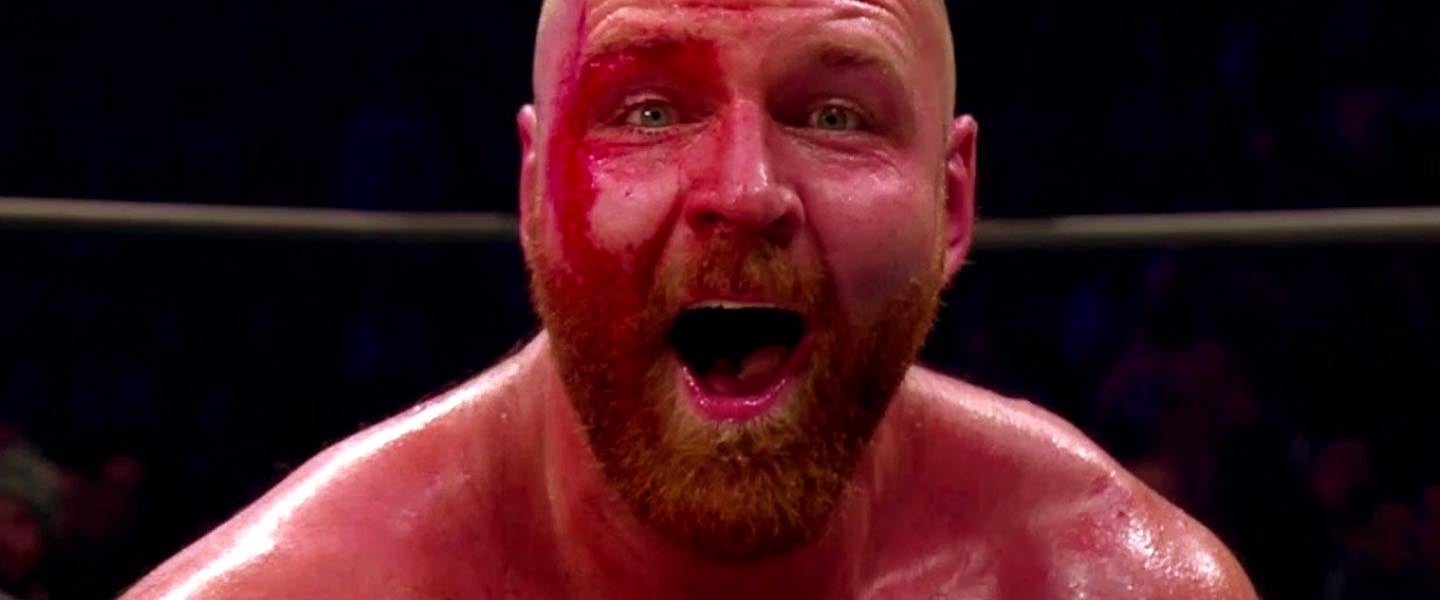This past Saturday night in Baltimore, All Elite Wrestling, the new startup backed by the ownership of the NFL’s Jacksonville Jaguars, held its third pay-per-view event, “Full Gear.” Most significantly, it was the promotion’s first such event since the launch of its weekly TV show, Dynamite. After the first two shows did improbably well for a group without TV coverage, it was time to see how AEW could do with more promotion and what kind of payoff it could give new fans who spent $50 after sitting through the first six episodes of Dynamite.
The top two matches on the card were very, very different. The “official” main event saw Chris Jericho retain the AEW World Championship over Cody Rhodes in a wonderful old-school world title-style match, one that maximizes the presence of the company’s two most over personalities while slowly building to a chaotic conclusion. It was followed, however, by a “lights out” match between heated rivals Jon Moxley (formerly Dean Ambrose in WWE) and Kenny Omega, who had been feuding since the end of AEW’s inaugural event during Memorial Day weekend.
The conceit of a “lights out” match is that since the promotion refuses to sanction it and washes their hands of it — in AEW, which tracks win/loss records, this means it “doesn’t count” — the lights will be turned off after the end of the “official” main event to signify the end of the show. After a few seconds, they’re turned back on so everyone can see the match. If nothing else, Omega and Moxley did their damnedest to live up to the billing of a match that storyline AEW couldn’t take responsibility for; while actual AEW tried its best to take responsibility for and make the match as safe as possible.
Overall, Omega vs. Moxley was, in style and presentation, the closest that mainstream American wrestling has ever come to the “death match wrestling” that’s developed an unflinchingly loyal cult following all over the world. While it’s meant different things over the years, these days, “death match” is usually understood to mean “lots of blood and sharp objects.” At times, it’s been an outlet for wrestlers with little to no talent or storytelling ability to be able to carve out (pun unavoidable) a space for themselves in the industry, but lately, the most prominent wrestlers in the sub-genre are skilled performers who happen to be into some seriously sick shit.
Moxley tried his hand at it a bit before he went to WWE, and when he released a hype video for his reborn non-WWE career as soon as his contract was up on May 1st, imagery suggesting a return to death matches was very much present throughout. That isn’t something you’d expect from a mainstream wrestler, but Moxley soon showed he wasn’t all talk. In fact, his first match in AEW was another “lights out” match, this time against fellow former indie daredevil Joey Janela. It delivered on such a promise without going too far, mainly leaning on some carefully-placed barbed wire and thumbtacks — i.e., it drew blood, but it wasn’t anything that WWE hasn’t experimented with.
— Jon Moxley (@JonMoxley) May 1, 2019
Omega, meanwhile, had his own “lights out” match with Janela in October, which was more reliant on crazy stunts with chairs, ladders and tables than sharp objects.
Neither match, though, could have prepared AEW fans, especially new ones, for what they saw on Saturday night. It was a near 40-minute war of attrition that featured Moxley’s barbed-wire bat, Omega’s barbed-wire broom (a nod to his past nickname, “The Cleaner”), a bag of broken glass, a large board covered in mouse traps, an ice pick, a “spider web” of barbed wire that was carted out next to the entrance ramp and moves onto the ring’s bare plywood boards after Moxley cut away the canvas mat and protective padding.
Reactions were mixed, to say the least; my immediate one was that I simultaneously loved and hated the match which, if nothing else, was overly long. Bruce Mitchell, probably pro wrestling’s best and longest running opinion columnist, writing for the Pro Wrestling Torch newsletter since 1990, tweeted that it was “torture porn” and a “geek show” squandering two “great wrestlers.” Arguably the most prominent takes, on Wrestling Observer Radio, from Dave Meltzer — wrestling’s longest-tenured reporter by far — and Figure Four Weekly founder Bryan Alvarez, were both negative. They felt it went way too far and would be a turn-off to much of the audience, which is fair.
Two great wrestlers.
Torture porn.
Geek show.
— Bruce Mitchell (@mitchellpwtorch) November 10, 2019
Then, though, things got weird. “I would like a ‘finality’ stip[ulation] to be a fight, not a spectacle, and this was meant to be as far as you would go in Big Japan [Pro Wrestling] and then five times farther, what you would do in CZW,” said Meltzer, referring to two of the longest-running “death match” promotions in the business.
Hold on a second there, Dave. You mean the same Big Japan that hosted a match with a piranha tank in the middle of the ring just months into its existence and never looked back? And the same CZW that once had a working relationship with Big Japan, hosts its annual death match tournament on the owner’s parents’ farm to avoid venue issues and once featured wrestlers falling from a roof onto a stack of light tubes and tables, retiring one of them in the process?
this was just a warm-up for the insanity Kodaka is gonna get into today for Big Japan Pro Wrestling@isami_777 #DDTUP #ddtpro #basara_pw pic.twitter.com/sXzDvJ9Wst
— ??Pumpkin Spiced Trans Am ☆ Catie?? (@catie__kaboom) November 4, 2019
As I hinted earlier, Full Gear wasn’t some low-budget carnival of masochism. While it was easy to lose oneself in the match, if you took yourself out of the moment at all, it was pretty clear that the two most potentially dangerous weapons — the pile of broken glass and web of barbed wire — were not the genuine article. (The ice pick, meanwhile, didn’t even touch anyone.) Yeah, there were some cuts on both guys from the bat and broom, which appeared to have some real barbed wire on them, but those were the implements that the wrestlers had the most physical control over. And, sure, some of the mouse traps were live — they were audibly going off as Omega writhed around on the board — but none snagged onto him, and it would make sense if only enough were set to be able to make the necessary noises.
In other words, torture porn it was not, which in a larger context, makes the outrage over the match borderline hypocritical. Because there’s a lot you can do in the ring that looks awful and gross without doing the same kind of damage that more traditional high-impact wrestling can do.
Case in point: Moxley himself once gave an interview explaining how the infamous CZW stunt where he took a skill saw to the forehead — the type of violence that draws the most criticism — was completely safe since it involved a dummy blade. It was so dull that he compared it to being as soft as “a baby’s ass,” and his opponent, the late Marvin “Brain Damage” Lambert, demonstrated how inert it was by using the saw on his own tongue. So even on the independent level, with a much lower budget than AEW or WWE, there’s a lot of room for illusion.
Not to mention, rough landings and shots to the head are the biggest long-term risk for most wrestlers’ futures, with serious neck and back injuries, knee and hip problems and brain trauma the potential result. Yet the head shots early in the Moxley-Omega match (with trash can lids, which may or may not have been the genuine article) and the various moves onto bare boards have generally not raised the ire that the barbed wire and glass stuff has, even with the latter mainly employing safe, largely inert props.
There’s nothing wrong with not liking the match, or expressing concern that it could turn off some of the new fans that AEW is trying to get to stick around. But treating it as beyond the pale doesn’t compute. If you reacted that way, that’s just your own gut reaction to the bloodletting, both real and perceived, and how the danger is more “immediate” than joint, spinal or brain injuries.
Because again, every time wrestlers take traditional flat-back bumps — or you know, multiple times per match — their bodies are absorbing the equivalent to a low-speed car crash. On the flip side, highly-trained, competent professionals with decades of experience getting a few cuts (or “blading”) in the ring, as long as they’ve had proper bloodwork done and know how to make sure that it doesn’t go beyond a few cuts, is really no big deal in the grand scheme of things. And if they augment that by using the creature comforts of big-budget wrestling to get the correct props to escalate the gore safely, they should be applauded, not shunned.

